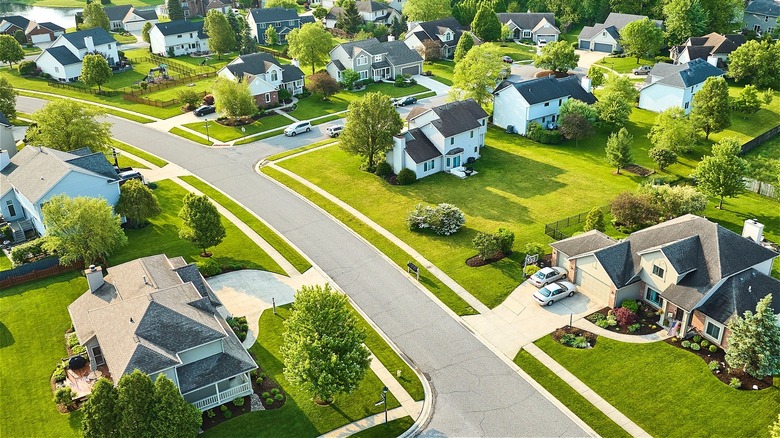How Homeowners Insurance Is Affecting The Housing Market
Even though homeowners insurance has typically been an afterthought during the homebuying process, it's increasingly affecting buyers' ability to close on a home. From increased premiums to a lack of providers, would-be homeowners today are facing more barriers than ever when it comes to purchasing, with homeowners insurance becoming a significant part of the problem. And as rates increase, many are finding their mortgage budgets shrinking in order to offset the sneaky ways insurance companies demand more money.
According to a Guaranteed Rate report, homeowners insurance rates have increased by 55% since 2019. However, these increases didn't affect all U.S. states evenly. S&P Global Market Intelligence reported that insurance companies raised homeowners' premiums by 11.3% on average in 2023 with 25 states experiencing rate changes of at least 10%. On the far end of these particular rate increases were Texas, Arizona, and Utah, which all experienced over 20% increases in their insurance rates in a single year. Part of this increase in insurance premiums is tied to how much more expensive home replacement costs have become. Yet, an even bigger part of the increase in homeowners insurance premiums is tied to climate change.
From materials to labor, rebuilding and replacement costs reportedly also increased 55% between 2019 and 2022, which has created additional concern for insurance companies as they face increases in natural disasters. According to the National Oceanic and Atmospheric Administration, 2023 had a record 28 weather and climate disasters compared to an average of 8.5 between 1980 and 2023. These disasters led to total losses over $1 billion.
The homebuying landscape
Even without significant insurance premium increases, the U.S. housing market is an increasingly difficult place for would-be homeowners today. With the Federal Reserve (or rather, this specific Fed committee driving interest rates) holding steady on the federal funds rate, borrowers can expect to see significantly higher interest rates on their mortgages, which can make budgeting for a monthly mortgage payment even more difficult. To make matters worse, though, despite initial predictions that the Fed would cut interest rates three times in 2024, policymakers now predict there might not be any rate cuts by the end of the year. This means those who might have been holding off on selling or buying a home could face a longer limbo or lock-in effect, which experts say is responsible for around 1.3 million fewer homes being sold in America from 2022 to 2023.
On top of this, housing prices themselves have skyrocketed. According to the Federal Reserve Bank of St. Louis, the median price for a home in the first quarter of 2014 was $275,200, almost 53% less than the $420,800 median home price in the first quarter of 2024. This has left many, even those with lower interest rates, paying the maximum of what their budget can afford. A 2024 study from Clever found that 43% of recent homebuyers reported struggling to make their mortgage payments on time. All of this has combined to create a financially strenuous housing market in which the addition of increased homeowners insurance can serve as the final straw for cash-strapped Americans.
States most affected by homeowners insurance changes
While you might expect certain states to top the list for most expensive homeowners insurance (like, say, California or Florida) you'll be surprised to learn that, according to Bankrate, the states with the most expensive premiums are actually Nebraska, Oklahoma, and Kansas. Of the 25 largest cities in the country, Oklahoma City had the highest average annual premium (at $5,476). These price hikes are largely due to the increased frequency of hail and wind weather events in the Midwest. In the last five years alone, Nebraska has experienced 17 NOAA-defined weather disasters, bringing its five-year average disaster costs to $2.5 billion.
With that in mind, certain states also face an increased risk of not just higher insurance premiums than the national average but also a lack of available coverage altogether. For instance, seven of the 12 largest home insurance companies in California have limited any new policies issued in the state. Farmers Insurance has capped how many policies it will issue for the state, while State Farm and Allstate have stopped issuing new home policies altogether.
Florida is facing similar issues with insurance companies, with 12% of all Floridians reporting having been dropped by an insurance company at some point, according to Redfin. Even Florida's state-created nonprofit homeowners insurance company, Citizens Property Insurance Corporation, reported it would be cutting policies even as the NOAA predicts above-normal hurricane activity for the 2024 season. Other coastal states, including Virginia, South Carolina, and Louisiana, are also facing dropped coverage and insurance company exits.


